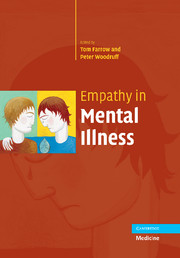Book contents
- Frontmatter
- Contents
- Foreword
- List of contributors
- Part I ‘Dysempathy’ in psychiatric samples
- Part II Empathy and related concepts in health
- 9 Neonatal antecedents for empathy
- 10 The evolutionary neurobiology, emergence and facilitation of empathy
- 11 Naturally occurring variability in state empathy
- 12 Neuroimaging of empathy
- 13 The neurophysiology of empathy
- 14 The cognitive neuropsychology of empathy
- 15 The genetics of empathy and its disorders
- 16 Empathogenic agents: their use, abuse, mechanism of action and addiction potential
- 17 Existential empathy: the intimacy of self and other
- 18 Empathizing and systemizing in males, females and autism: a test of the neural competition theory
- 19 Motivational-affective processing and the neural foundations of empathy
- 20 Face processing and empathy
- Part III Empathy models, regulation and measurement of empathy
- Index
14 - The cognitive neuropsychology of empathy
from Part II - Empathy and related concepts in health
Published online by Cambridge University Press: 17 August 2009
- Frontmatter
- Contents
- Foreword
- List of contributors
- Part I ‘Dysempathy’ in psychiatric samples
- Part II Empathy and related concepts in health
- 9 Neonatal antecedents for empathy
- 10 The evolutionary neurobiology, emergence and facilitation of empathy
- 11 Naturally occurring variability in state empathy
- 12 Neuroimaging of empathy
- 13 The neurophysiology of empathy
- 14 The cognitive neuropsychology of empathy
- 15 The genetics of empathy and its disorders
- 16 Empathogenic agents: their use, abuse, mechanism of action and addiction potential
- 17 Existential empathy: the intimacy of self and other
- 18 Empathizing and systemizing in males, females and autism: a test of the neural competition theory
- 19 Motivational-affective processing and the neural foundations of empathy
- 20 Face processing and empathy
- Part III Empathy models, regulation and measurement of empathy
- Index
Summary
Introduction
Despite the plethora of definitions of empathy, most authors generally agree that it implies at least three different aspects: feeling what another person is feeling; knowing what another person is feeling; and having the intention to respond compassionately to another person's distress. Note that these aspects may be experienced independently from one another and constitute different levels of complexity ranging from empathic mimicry to sympathy. Moreover, regardless of the particular terminology used by different scholars, there is broad agreement that empathy involves three primary elements: (1) an affective response to another person, which often, but not always, entails sharing that person's emotional state; (2) a cognitive capacity to adopt the perspective of the other person; and (3) some monitoring and self-regulatory mechanisms that keep track of the origins of self and other feelings (e.g. Batson, 1991; Decety & Jackson, 2004; Ickes, 1997). The multidimensionality of the empathy construct makes it less amenable to traditional methods of study and investigation.
We propose in light of the current knowledge in neuropsychology and cognitive neuroscience a model of empathy that relies on four intertwined major functional components that dynamically interact to produce this intersubjective experience. The first component, affective sharing, is based on a perception-action coupling mechanism and resulting shared representations between self and other (Preston & de Waal, 2002). Self-other awareness constitutes the second component. Empathy requires that there is no confusion between self and other even though some temporary identification between the observer and its target may occur.
- Type
- Chapter
- Information
- Empathy in Mental Illness , pp. 239 - 260Publisher: Cambridge University PressPrint publication year: 2007
- 11
- Cited by



